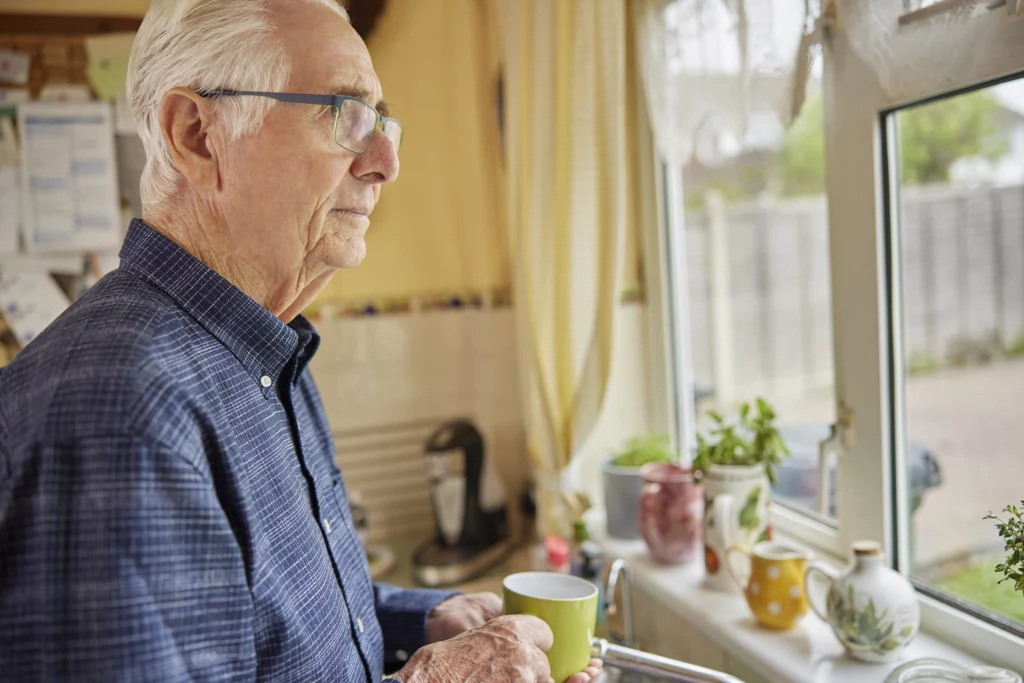
6 Types of Dementia: What You Need to Know about them All
This post may contain affiliate links or Google Ads and we may earn a small commission when you click on the links at no additional cost to you. As an Amazon Affiliate, we earn from qualifying purchases. This is at no additional cost to you and helps with our website expenses.
In this article, we will discuss the different types of dementia and their corresponding symptoms. We will also provide tips for caregivers on how to best care for someone with each type of dementia.

The term dementia is used to describe several symptoms that severely affect a person’s intellectual and social abilities, to the point where it interferes with their daily life. Dementia can be caused by a variety of diseases, including Alzheimer’s disease, vascular dementia, and Lewy body dementia. Each type of dementia has its own unique set of symptoms.
Alzheimer’s Disease – The Most Common Type of Dementia
Alzheimer’s disease is a degenerative brain disorder that leads to impairments in memory, thinking, and behavior. It is the most common type of dementia, accounting for 60-80% of cases. The disease is characterized by the buildup of abnormal proteins in the brain, which causes nerve cells to die. This leads to a decline in cognitive function and eventually results in dementia.
Symptoms of Alzheimer’s disease typically develop slowly and worsen over time. Early signs may include difficulty remembering recent events or conversations, trouble solving problems, and changes in mood or behavior. As the disease progresses, patients may experience severe memory loss, confusion, and hallucinations. There is no cure for Alzheimer’s disease, but treatments are available to help manage symptoms and slow the progression of the disease.
Quick Facts about Alzheimer’s Disease
- Most people who develop Alzheimer’s disease are over 65 years old. It is referred to as late-onset Alzheimer’s.
- About 1 in 9 people who are 65 years old or older have Alzheimer’s dementia.
- Women have Alzheimer’s disease more frequently than men. Almost two-thirds of Americans with Alzheimer’s disease are women.
- You don’t need to have a family history of Alzheimer’s to get the disease. However, if you have a parent or sibling with Alzheimer’s, you are more likely to get the disease than someone without a first-degree relative with Alzheimer’s.
- In the early stages of Alzheimer’s the brain can compensate for some symptoms so people can continue to function somewhat normally.
Caregiver Tips for Alzheimer’s Disease

As the population ages, the number of people diagnosed with Alzheimer’s Disease is on the rise. For many of these patients, their care will fall to loved ones and friends. While caring for someone with Alzheimer’s can be a rewarding experience, it can also be challenging.
First, it’s important to keep your own health in mind. Caring for someone with Alzheimer’s can be physically and emotionally draining, so make sure to take time for yourself. Go for a walk, read your favorite book, or just take a few minutes to relax. It’s also important to build a support network of family and friends who you can rely on when things get tough.
Second, try to create a routine for the person you’re caring for. Consistency can help to ease some of the confusion and frustration that comes with Alzheimer’s. Establish regular times for meals, medication, bathing, and sleep. If possible, stick to the same routine each day.
Third, don’t hesitate to ask for help when you need it. There are many resources and support groups available to caregivers of Alzheimer’s patients, so don’t be afraid to reach out if you’re feeling overwhelmed. Remember, you’re not alone in this journey.
Vascular Dementia – Caused by a Series of Strokes that Damage the Brain
Vascular dementia is caused by a series of mini-strokes that damage the brain, atherosclerosis, or heart disease. The mini-strokes occur when the blood supply to the brain is blocked, usually as a result of atherosclerosis (narrowing of the arteries). Vascular dementia can occur suddenly or gradually, and it can get worse over time.
Symptoms include memory loss, confusion, problems with planning and organization, mood swings, and depression. There is no cure for vascular dementia, but there are treatments that can help to improve symptoms and slow down the progression of the condition. These include lifestyle changes (such as quitting smoking and exercising regularly), medication (such as antiplatelet drugs and cholesterol-lowering statins) and surgery (such as angioplasty).
Quick Facts about Vascular Dementia
- The five-year survival rate for someone with vascular dementia is estimated to be 39%. However, the survival rate for healthy persons of the same age is estimated to be 75%.
- The guidelines for treating cognitive decline in VaD emphasize that donepezil can be useful in improving cognitive status.
- Neurological exams can show problems with movement, speech, and urination.
- Neuropsychological exams see the loss of cognition, problems finding words, and learning difficulties.
- Memantine and donepezil medications can be useful for patients with vascular dementia.
Caregiver tips for Vascular Dementia
Caregivers of people with vascular dementia may have some distinctive challenges, but there are some tips that can help make the caregiving process a little easier.
One of the most important things caregivers can do is to keep the person with vascular dementia as active as possible. Exercise has been shown to improve cognitive function and may help slow the progression of dementia. Additionally, caregivers should encourage the person with vascular dementia to socialize and engage in activities that they enjoy. Stimulating the mind can help reduce cognitive decline.
It is also important for caregivers to be patient and understanding. People with vascular dementia may experience mood swings or periods of confusion. However, try to remain calm and avoid arguing or correcting the person unnecessarily. It is also important to provide plenty of support and assistance with activities of daily living, such as bathing, dressing, and eating.
Lewy Body Dementia – Abnormal Protein Deposits in the Brain
Lewy Body Dementia (LBD) is a type of degenerative brain disease that is characterized by the abnormal buildup of proteins, known as Lewy bodies. These deposits cause damage to nerve cells, resulting in a decline in cognitive function. Lewy Body Dementia often affects the same areas of the brain as Alzheimer’s disease and Parkinson’s disease, and it shares many of the same symptoms.
However, Lewy Body Dementia typically progresses more rapidly than other types of dementia, and it can also cause hallucinations and delusions sooner than other types of dementia. There is no cure for Lewy Body Dementia, but treatments are available to help manage the symptoms. Early diagnosis is essential for maximizing the effectiveness of these treatments.
Quick Facts about Lewy Body Dementia
- Lewy Body Dementia affects approximately 1.4 million people (according to the Lewy Body Dementia Association). It is said to be the second most common form of dementia.
- LBD is notoriously hard to diagnose. There is no test, like an MRI, CT scan, PET, or blood test that can definitely diagnose it. Only after death in an autopsy can you identify LBD.
- There are many medications NOT to use for Lewy Body Dementia. These include medications like Haldol, Thorazine, and Prolixin.
- One of the distinguishing signs of LBD is hallucinations in the beginning stages.
- REM sleep behavior disorder is more common in people with Lewy Body Dementia.
Caregiver Tips for Lewy Body Dementia
Encourage your loved one to stick to a routine. This can help to minimize confusion and anxiety. Simplifying household tasks and providing clear instructions can also be helpful. Be patient and understanding. Lewy body dementia can cause mood swings and paranoia.
Try to provide opportunities for social interaction and activity. This can help stimulate the mind and provide a sense of purpose. Physical therapy and exercise are very important and can greatly help. Hallucinations and Capgras syndrome are common. Learn to redirect or go along with them so as not to anger or frustrate your loved one.
Seek support from other caregivers. You are not alone in this journey. There are many resources available to help you care for your loved one.
Frontotemporal Dementia – One of the Types of Dementia in the Frontal Lobes

Frontotemporal dementia (FTD) is brain disorders that affect the frontal lobes of the brain. This can cause changes in personality and problems with language. FTD is the most common form of early-onset dementia, accounting for 20-30% of all cases. The average age of onset is 55 years old, although it can occur as early as 40. It affects the lobes in the front of the brain, causing personality changes and language problems.
FTD is more common in men than women. The cause of FTD is unknown, but it is believed to be related to a combination of genetic and environmental factors. There is no cure for FTD, but treatments are available to manage the symptoms. Treatment options include medications, occupational therapy, and speech therapy.
FTD can be a devastating disease, not only for the person affected but also for their family and friends. However, with proper diagnosis and treatment, people with FTD can manage symptoms for some time.
Quick Facts about Frontotemporal Dementia
- FTD is a decline in behavior, language or movement that gets worse over time. Memory is usually not affected as much as other things.
- If someone has FTD, they are more likely to get sick over time from things like pneumonia, infection, or being hurt in a fall.
- Aphasia is common with frontotemporal dementia. This affects speech ability and the ability to understand language.
Caregiver Tips for Frontotemporal Dementia
For caregivers, managing FTD can be a challenge. Here are some tips to help you care for a loved one with FTD.
Encourage social interaction: patients with FTD often become socially withdrawn, so it’s important to encourage them to interact with others. This can be done by inviting friends and family over for visits, taking them to community events, or joining a support group.
Maintain a routine: patients with FTD may have difficulty with executive functioning, so it’s important to establish a daily routine and stick to it as much as possible. This will help them stay on track and minimize frustration.
Encourage positive activities: patients with FTD may become fixated on negative thoughts or engage in destructive behaviors. It’s important to encourage positive activities that bring them joy and distraction from their disease. This could include hobbies, puzzles, or listening to music.
Be patient: patients with FTD may act out in ways that are frustrating or confusing. It’s important to remain patient and understand that their behavior is a result of the disease and not intentional.
By following these tips, you can make life easier for both you and your loved one while managing FTD.
Mixed Dementia – A Combination of Two or More Types of Dementia
Dementia is a general term for a decline in mental ability severe enough to interfere with daily life. Memory loss is an early symptom of dementia. Other early symptoms may include problems with planning and organization, decision-making, language, and vision. As the disease progresses, people with dementia may experience personality changes and behavioral issues. They may become agitated or see things that are not there. Dementia affects people in different ways, and the symptoms can vary from mild to severe.
There are many different types of mixed dementia, but common combinations are Alzheimer’s disease and Lewy Body Dementia or Alzheimer’s and vascular dementia. less common types include frontotemporal dementia, vascular dementia, and mixed dementia. Mixed dementia is a combination of two or more types of dementia.
People with mixed dementia tend to have more severe symptoms than those with Alzheimer’s disease or Lewy Body Dementia alone. There is no one-size-fits-all approach to managing mixed dementia, but treatments typically focus on managing the individual symptoms of each type of dementia involved. In some cases, management may also involve addressing underlying health conditions that can contribute to cognitive decline.
Quick Facts about Mixed Dementia
- Some people can have brain changes to three different dementias, Alzheimers, Lewy Body Dementia, and vascular dementia.
- The symptoms of mixed dementia may be different, depending on the types of brain changes and which areas of the brain are affected.
- Many researchers believe that if we better understand mixed dementia, and realize that vascular changes are the most common brain change with it, we may be able to reduce the number of people who get dementia.
- Keeping overall risk factors for heart and blood vessel diseases under control may also protect the brain from vascular changes.
Caregiver Tips for Mixed Dementia
Caring for a loved one with dementia can be difficult and challenging, especially if your loved one has more than one type of dementia, it is important to be aware of the different symptoms and how they may progress.
Be patient: One of the most important things you can do is to be patient with your loved one. Dementia can cause fluctuations in mood and energy levels, so try to be understanding if your loved one is having a bad day.
Encourage socialization: It is important for people with dementia to stay socially active. Even if your loved one is not able to go out and meet new people, there are still ways to encourage socialization, such as joining a support group or attending activities at a senior center.
Make sure the environment is safe: People with dementia may wander or become agitated, so it is important to make sure the environment is safe. Remove any tripping hazards, make sure doors and windows are locked, and install an alarm system if necessary.
Parkinson’s Disease Dementia – One of the Types of Dementia
Parkinson’s disease is a neurodegenerative disorder that affects the movement and coordination of the body. People with Parkinson’s often experience tremors, stiffness, and slowing of movement. In some cases, the disease can also lead to cognitive problems, such as difficulty with memory, decision-making, and executive function. This condition is known as Parkinson’s disease dementia (PDD).
There is no cure for Parkinson’s disease dementia, but treatment focuses on managing symptoms and supporting patients and caregivers. There are many resources available to help people cope with the challenges of this condition. With early diagnosis and proper management, people with Parkinson’s disease dementia can maintain a good quality of life.
Quick Facts about Parkinson’s Disease Dementia
- 83% of people with Parkinson’s that survive for year years have dementia.
- Symptoms of Parkinson’s disease dementia include fluctuation in moods, anxiety, speech that is slurred, hallucinations, lower energy, paranoia, less appetite, sleeping problems.
- Symptoms can be similar to Lewy Body Dementia
- There is no medical test to diagnose PDD
- Men are more prone to Parkinson’s disease dementia.
Caregiver Tips for Parkinson’s Disease Dementia
PDD can cause visual perception problems. Keeping lights on can help.
The symptoms of Parkinson’s disease dementia can be very challenging for caregivers, who must often provide around-the-clock care and assistance. However, there are some things that caregivers can do to ease the burden.
First, it is important to keep the person with Parkinson’s disease dementia as active as possible. This can help to slow the progression of the condition and prevent boredom and depression. Second, caregivers should provide plenty of opportunities for social interaction, whether through one-on-one conversation or group activities. Finally, it is important to be patient and flexible when caring for someone with Parkinson’s disease dementia.
The symptoms of the condition can change rapidly, and caregivers must be prepared to adjust their caregiving approach accordingly. Try to limit distractions: use lights, curtains, and clocks to keep them on a sleep schedule that is regular.
Conclusion. While there are many different types of dementia, these six types of dementia account for the vast majority of cases. If you or someone you love has been diagnosed with dementia, it’s important to understand which type it is, as this will dictate treatment options and help you to better understand what to expect.
Do you have experience with any of these types of dementia? Let us know in the comments below.




